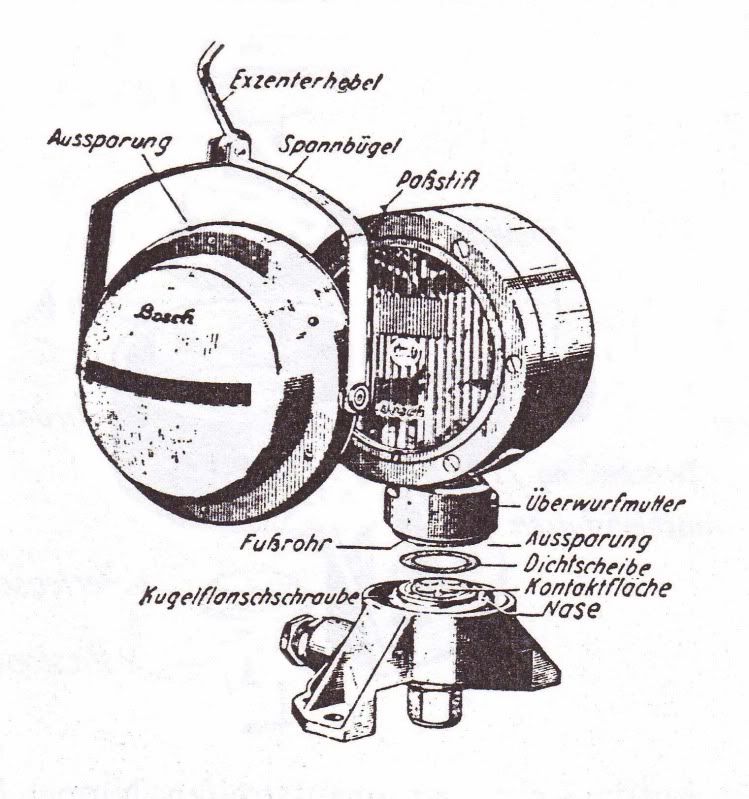Page 2 of 2
Posted: Thu May 06, 2010 5:18 pm
by Roland Mann
Hi Brian,
may i add another information to the never ending story of precise headlights. When looking through my book " Werkstatthandbuch zum Motor Maybach-Motor HL 230 P 30 - HL 210 P30" for Panzerkampfwagen Panther there is a little appendix just for the BOSCH headlights. From there I copied the base and the head for more light in this discussion. OK, its all in German but Brian and Kent should have no probles to read as fare as I know.
Quiet an exercise for you to replicate this construction in scale Brian. Good luck and if I can be of further help, let me know.
Best regards Roland

[/img]

Posted: Thu May 06, 2010 5:49 pm
by Kent Wiik
Outstanding Roland!
Those drawings says it all, thanks!
May I ask:
In that book of yours is there possible a drawing of the tubular convoy light?
If so you may have the answer to the million $ question what they looked like, a simple glass tube with a blue light (I doubt it) or a tube with 4 green squares or something else.
Some how none of them seem to have survived the war and no ww2 photo is clear enough to tell the story.
Maybe the answer is in your book? Fingers crossed…

Kind regards
Kent
Posted: Thu May 06, 2010 6:18 pm
by Roland Mann
Hi Kent,
sorry not a sign of a convoy light in this book. As I said the book is about the engine and I was surprised it contained this info of the head lights. Any way I keep searching. One day .......
Roland
Posted: Thu May 06, 2010 8:25 pm
by Tim Bowman
Excellent Roland! Thank you for that.
Brian,
The part labeled kontaktplatte(top pic) and kontaktfache(bottom image) is the "white-porcelin looking socket I was talking about. the receptacles are lined with contact metal of course...copper?
Still trying to find the photo I know I have somewhere.
Tim
Posted: Thu May 06, 2010 8:51 pm
by Brian Leach
Roland, Kent, Tim,
Thanks for all this help.
That picture that you sent Roland is great, but I am a little confused. What is it that holds the light to the base? I had expected some kind of bolt or screw, maybe a twist lock to keep it from jouncing out of the socket.
I rode on a soviet AA tank for a project at work ten years ago and I thought my fillings were going to fall out. I cannot expect the Tiger was all that better over counrty.
This should be interesting. I am as of yet just trying to get an idea if this is possible. With LEDs there is not much current so I really think this is possible. I need to machine the PIII suspensiion arms this weekend, than see how they work.
And just FYI, I studied German at University, though I would be hard pressed to prove that now. It seems to work best after a few Hefeweizen Biers.
Oh, and Roland, I think I will try and get that book you cite. the engine info could be helpful to me too. Thanks.
Thanks all,
Brian
Posted: Thu May 06, 2010 9:24 pm
by Roland Mann
Hi Brian,
fitting the top to the base is as follows :
The Kugelflaschschraube is hold down in the base by the big bottom elastic Stopmutter. The top light housing is hold down to the Kugelflanschschraube by this Ãœberwurfmutter. So the electric kontacts in the Kugelflanschschraube are pressed to some counter parts ( electric ) in the top , not shown.
The Kugelflanschschraube ( ball flange bolt ) allows to angle the light in to the correct direction as it is done on a normal older car head beam. Those angles however are very limited by a pin called Paßstift. So there was no way to turn the light to the left or right or backwards.
Any more question ? Roland
Posted: Thu May 06, 2010 10:18 pm
by Brian Leach
Roland,
Thnaks for the explanation. It was not clear to me from the pictures that the Ãœberwurfmutter screws into the Kugelfussschraube. it looks (to me) as if it just plugs in. Your explantion is what makes good sense.
Thank you again for your patience!
Brian



